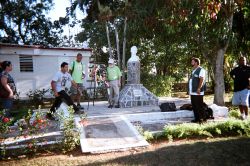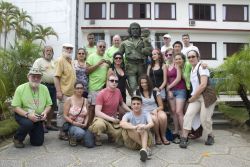Halifax Media Co-op
News from Nova Scotia's Grassroots
The Ernesto “Che” Guevara Volunteer Work Brigade
My Experience of the 2011 Brigade
by Charles Spurr
I believe it was Che Guevara who said that volunteer work is a school to create consciousness. He meant that through volunteer work one developed a connection with one’s community and society. In this case we went to Cuba to make a connection with the Cuban society in a direct, hands-on way.
Twenty-two of us from different parts of Canada met for the first time in the Toronto Pearson Airport in April 2011 for a two-week brigade experience. Normally, the brigades go to Cuba for three weeks but this year’s brigade was shortened because the 6th Congress of the Communist Party of Cuba was just concluding, taking some of the resources that would have otherwise been directed to the brigades.
Similar to previous brigades, we spent the first week in the Julio Antonio Mella International Camp near the town of Caimito on the outskirts of Havana, where we attended the International Workers Day on 1st May. We also toured the area and worked on agricultural concerns associated with the Camp that was run by the Cuban Institute for Friendship with the Peoples (ICAP is the Spanish acronym).
Like all delegations entering the International Camp, we began with an official welcoming ceremony, where we laid a wreath at the monument to Julio Antonio Mella, and listened to the Camp director explain who he was and what he did. Later we would see likenesses of him painted throughout Cuba. He was a communist youth organizer in the 1920’s who founded the original Communist Party of Cuba. He was forced into exile in Mexico and was later murdered in Mexico City by agents of the Cuban dictator Machado. His last words were said to be, “I die for the revolution.” Today he symbolizes the Communist Youth organization, and he appears with Che and Cienfuegos on the signs of this organization.
So here we were in Cuba, a small island country of eleven million that has been blockaded by the U.S. empire for fifty years during which it was an object of contention between the super powers yet managed to maintain some degree of independence while building socialism. With us in the camp were representatives of some thirty or forty other countries who were here for May Day and volunteer work programs. There was a feeling of expectation and excitement about this strange new country that seemed to defy the prejudices that many had about the word “communist.” Many, like myself, were experiencing a socialist country for the first time. A few had some connection with the communist movement but most were just curious and sympathetic with the plight and accomplishments of the Cuban people on some level.
During our stay in this area we did agricultural work twice, visited a co-operative farm, toured Havana, visited the Jose Marti monument and museum, visited the Latin America School of Medicine, attended an evening party at the Friendship House, met with an official with the National Assembly of Peoples Power, met members of the Communist Youth, Cuban veterans, members of the Cuban Federation of Women, attended an international gathering of labour in solidarity with Cuba, and met a famous Cuban singer/songwriter Sara Gonzeles. The whole spectrum of Cuban society seemed to swirl about us. I say “spectrum” because we could see every walk of life and every aspect of life in Cuba.
Often I have heard people saying things like, “I can’t believe we’re in a communist country,” and there is a lot of confusion about whether Cuba is “communist” or “socialist.” I think that such views could be explained to a great measure by the Cold War culture in which we live. I used to know people who were involved with the Canada-Albania Friendship Association back in the day when Albania was still a socialist country. Much like those in the Canadian Network on Cuba, CAFA members made many trips to Albania over the years for a variety of reasons. The way they described their experiences in that country sounded in many ways similar to our experiences in Cuba, and Albania was said, at that time, to be the last bastion of hard core Stalinism. Of course these are different times, and Cuba has to cope with being a small socialist island in a huge sea of capitalism.
Another comparison was made by a member of our brigade who had recently visited North Korea. He said that North Korea was very much like Cuba although security in the DPRK was much tighter since they were in the middle of very tense military struggle with the US. There was also a woman from the US who has written extensively about Cuba. She noted that the famous Cuban medical system owes much of its character to the medical system of the former Soviet Union. These are a few examples. So I think that visiting Cuba helps to break down many of the ‘iron curtain’ myths that many of us have grown up with.
I have so many indelible memories of Cuba that to name them all would result in a lengthy discourse. So I would like to mention only a few.
During the May Day celebration in Havana there was one incident that stood out. Before things got started I was looking up at the podium, speculating about who the different dignitaries were. In one section there was a group of military officers. One of them, Asiatic by appearance, stood out because of his large military hat. Later, the march and rally were utterly amazing, and all of us were jumping up on chairs, waving flags and arms, and cheering enthusiastically. Beside me, was a Korean student who had brought a DPRK (North Korean) flag and was waving it energetically. The next time I looked back in that direction, the same military officer from the podium was standing next to me. He was from North Korea, had seen that somebody was waving his country’s flag, and came down to meet this person. It was a very pleasant and surprising encounter.
On another occasion, we were in Cienfuegos, and went on a road trip to Santa Clara which is in the interior, to visit Che’s mausoleum. There was a huge monument to the Cuban/Argentinian hero with a giant statue of Che on top of it. Inside the monument there was a museum, and before entering it, we were taken into the crypt where Che and many of his comrades from the ill-fated Bolivia campaign had been put to rest. I remember reflecting upon this campaign that ended with Che’s capture and assassination by order of the CIA. This tragedy reflected the greater conflicts occurring on a world scale at that time.
Nikita Khrushchev had been in power for a number of years during which he had been running anti-Stalin campaigns, and taking the Soviet Union in a very different direction. The Cuban missile crisis had taken place, as had the failed US Bay of Pigs invasion. Khrushchev was opposed to armed struggle, except, of course, for the armed struggle of the Soviet military under his control. The whole world was to bow down to those countries with the most nuclear weapons.
Che, in contrast, was very much in favour of armed struggle, but not the armed struggle of the Soviet military under Khrushchev’s control, but of the locals for their liberation. In Bolivia, the Communist Party of Bolivia, which had ties to Khrushchev, withdrew support from Che’s mission. It is possible that Khrushchev had an agreement with the US that he would help protect US interests in its sphere of influence. Yet another party, the Communist Party of Bolivia (Marxist-Leninist), supported Che, although it was much smaller and newer with much less influence. So Che’s Bolivia campaign ended badly, and we had privilege of witnessing a memorial to it, and Che’s whole life, in Santa Clara, the location of Che’s greatest victory.
Hasta siempre Comandante Che Guevara!
Of course, being a Latin American and Caribbean country Cuba has different characteristic from other socialist countries. This is only natural. There is no snow, and plenty of palm trees, and mangoes. People don’t dress in furs —artificial or natural. The language is Spanish and the dominant culture is the culture of this region.
Cuba has its own unique history, its own rich intellectual heritage, and its own unique thought material, just like other countries. One striking fact is the attention Cubans pay to Jose Marti. There are countless monuments to Marti in Cuba including the one in Revolution Square, on the same scale as the monument to Che in Santa Clara. Being in the capital, Marti’s monument might be seen as having pride of place. He is the most important of Cuban national hero, and innumerable volumes have been written about him, and his writings are widely read and studied. One often quoted saying of Marti is “Patria es humanitad.” That is the homeland is humanity. It is not a bad start for a future socialist state.
Marti was one of the leaders of the Cuban independence movement who died in 1895, in battle. He is credited for starting the movement that successfully freed Cuba from Spanish rule. He is often equated with Simon Bolivar, and other Latin American heroes.
Cuba shares its rich popular culture, not only with the Caribbean and Latin America, but also with North America, and many other countries. Such divers musical styles as rap, bi-bop, jazz, etc., which are also found in North America, are also popular in Cuba. So there seems to be a cultural crossover with Cuba. This makes it easier for North Americans to identify with it than eastern Europe or Asia. This is one of the things that Canadians experience when visiting Cuba. We also share a similar colonial past, as well as economic and cultural ties. All of this makes it easier to appreciate Cuba’s struggle to maintain its independence from the US colossus.
That’s enough of my experiences. Why not experience the Che Guevara Volunteer Work Brigade for yourself? Here is how.
VOLUNTEER IN CUBA
Join the 2013 CHE GUEVARA WORK BRIGADE
Canadian Brigadistas in Cuba
• Spend three weeks in Cuba doing agricultural or other work alongside Cubans
• Connect with Cubans to learn from each other
• Gain a personal and intimate understanding of Cuba’s achievements and resistance
Cost: $1175 Plus Airfare. Departure from Toronto 23rd April – Return 15th May
A non-profit project of the Canadian Network on Cuba (CNC) and Instituto Cubano de Amistad con los Pueblos (ICAP)
For more info:
www.canadiannetworkoncuba.ca/brigade
chevolbrigade@gmail.com
Ph.905-382-3468
The site for the Halifax local of The Media Co-op has been archived and will no longer be updated. Please visit the main Media Co-op website to learn more about the organization.




